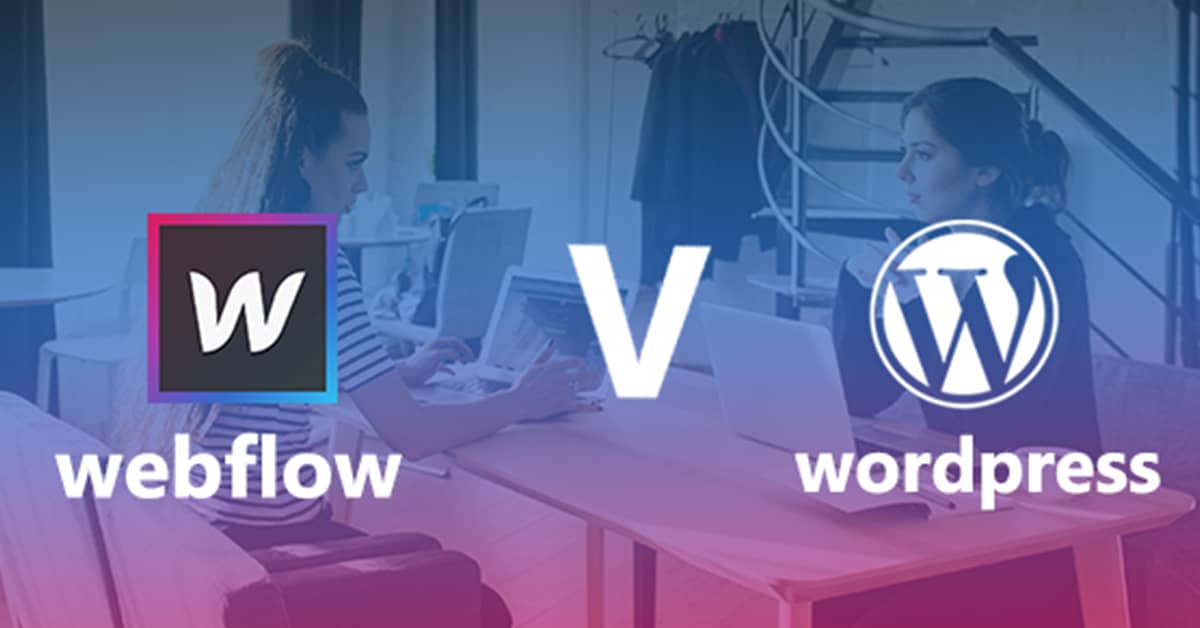A well-built website is a critical factor for establishing successful entrepreneurship in this modern competitive business world. Both WordPress and Webflow are two of the most popular digital platforms for building websites. Content management systems (CMS) like these two are specially designed to provide almost everything you need to create or enhance your website. However, if you are a newcomer to web development services, you might find it daunting to decide where and how to start building the process of websites.
WordPress and Webflow are two very similar platforms serving the same purpose with some alterations. These two platforms are widely used all over the world for creating websites. Although WordPress is the most commonly heard name among all the other CMS platforms, Webflow is emerging as one of its tough contenders in the field. According to the data, more than 34% of all the websites worldwide have been made with WordPress. This article will discuss and compare the different features of these platforms for a better and detailed understanding.
Table of Contents
Toggle
1) Overview: Webflow vs WordPress
The main aim of these two platforms is to simplify the online experience. WordPress is the most commonly used PHP based open-source CMS in the market. It simplifies the job of the web development services with its very flexible back-end process with tons of customization features. You will have the liberty to design your website using several plug-ins for checkout processes, SEO, etc.
Whereas, Webflow is a SaaS cloud-based web designing platform. Webflow offers you a great range of website-building canvases. It has a varied collection of in-depth tools, making it as strong as a CRM in WordPress.
Read More:- How Google Analytics is Helping Web Developers in UI/UX Design

2) Pricing: Webflow vs WordPress
Pricing is a crucial factor that anyone has to consider to ensure that the CMS plan matches the budget. Webflow offers you two types of price plans that you can choose from. The first one is the website plan, and the other one is the business plan. The website plan ranges from $12 to $16 per month, and the business plan varies from $29 to $36 per month, depending on the features and functionality you are looking for. There are a few yearly plans as well to consider. But there are no free plans on Webflow; however, you can begin with a trial version.
On the other hand, WordPress is an entirely free open-source platform. However, you will have to invest money for some additional features on your own. The final cost of website building in WordPress depends on how basic-level or high-end you want your site to be. Perhaps this is the best part about WordPress that the control will be in your hand on where your funds will be allocated.

3) Ease of use: Webflow vs WordPress
Webflow has a very brandable quality. Professional web development services can also sell their products using the expert capabilities of this platform. The visual editor in this platform is incredibly advanced, as it has tons of templates and other features. It is more apt for the professionals; the beginners may find it a bit difficult to operate.
WordPress is, on the contrary, a lot easier to operate. That is why it is being used by so many different levels of users for building different websites from all the different corners of the world. Adding content to your website is extremely easy with WordPress. It has beautiful layouts that you can use to make your website look attractive without even adding content. There are thousands of ready-made free templates and plug-ins to help you do everything you want without using any codes.

Read More:- How Having A Mobile App Can Boost Your eCommerce Business
4) Design tools: Webflow vs WordPress
Webflow is a web development service that lets you control everything from JavaScript to HTML. It has a drag-and-drop interface that helps you build a perfect website from a blank page in no time. There are dozens of free and paid mobile-responsive templates that can be used for different kinds of websites. Webflow also lets you make animations and custom interactions all over your website without even using a single line of coding.
Alternatively, in WordPress, you don’t get to start from a blank canvas. They will offer you a range of free or premium themes that you will have to choose from and start making customizations on it as per your need. Or you can make a theme of your choice to get started with WordPress. You will also be able to use plug-ins for adding different features to your website.

5) Content management: Webflow vs WordPress
Webflow is designed to work for all professionals, from web designers to web developers. You will be able to create your content on the web page. You can also introduce some advanced features for showing the contents by filters and add the search feature to your website. Editing your content at any point in time is also very easy. Merged with some other tools, the contents in Webflow can look very appealing.
WordPress was initially designed to be a blogging tool. That is why adding and editing content in WordPress is super easy. You have the flexibility to add as many pages as you choose according to your website’s requirements. As your business will grow, you will add multiple users, different access permissions, and other unique components.

Read More:- How Remarketing Is Helping Small Businesses To Grow Digitally
6) E-commerce features: Webflow vs WordPress
If you are looking to earn from your website and list it as an e-commerce site, you can get help from Webflow and WordPress. You can customize each page from the product preview to the final checkout page. Adding products to your e-commerce sites is very simple. You can even add the transactional email feature to your website to increase credibility and personal relationship with your customers. However, it is not ideal for selling subscription-based or membership products.
WordPress has an excellent free plug-in for developing e-commerce sites called WooCommerce, preferred by millions of small and large-scale online businesses worldwide. It comes with tons of useful add-ons/plug-ins and themes of its own that make it extremely easy to use. It also allows you to add dozens of payment gateways too. WordPress also has many other shopping cart plug-ins.

The Bottom line
With this information, we hope you will have the right information to decide which content management system you will use to build your website. They both are very popular among web development service providers and other professionals or non-professional users. Both of these platforms have a different and unique set of pros and cons. However, to sum up, the entire content can say that Webflow is a more professional tool to be used by skilled and experienced users. In contrast, WordPress has a universal approach among all users.


